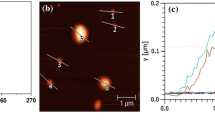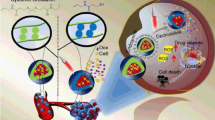Abstract
Purpose
In this study, we developed a polymeric micellar system for glutathione-mediated intracellular delivery of a photosensitizer, chlorin e6 (Ce6) by synthesizing an amphiphilic polymer, methoxy-poly(ethylene glycol)-poly(D,L-lactide)-disulfide-Ce6 (mPEG-PLA-S-S-Ce6), which self-assembled in aqueous environment to form micelles.
Methods
The polymer-drug conjugate was characterized by NMR. The singlet oxygen (2O1) generation and in vitro release of Ce6 micelles were evaluated. Further, glutathione-mediated intracellular drug delivery was assessed in human alveolar adenocarcinoma cells (A549), mouse mammary carcinoma cells (4 T1) and 3D A549 spheroids.
Results
The micellar system protected Ce6 from aggregation leading to improved 2O1 generation compared to free Ce6. Due to the availability of glutathione, the disulfide bonds in the micelles were cleaved resulting in rapid release of Ce6 evident from the in vitro study. The Ce6 micelles displayed quicker drug release in presence of glutathione monoester (GSH-OEt) pre-treated A549 and 4 T1 cells compared to without pre-treated cells. In vitro phototoxicity of micelles displayed enhanced toxicity in 10 mM GSH-OEt pre-treated A549 and 4 T1 cells compared to untreated cells. As anticipated, Ce6 micelles showed lower drug release in presence of 0.1 mM of buthionine sulfoximine (BSO) pretreated A549 and 4 T1 cells exhibiting lower phototoxicity. Further, A549 3D spheroids treated with Ce6 micelles showed significant inhibition in growth, enhanced phototoxicity, and cellular apoptosis in comparison to free Ce6.
Conclusion
The above results showed that the developed strategy could be effective in improving the PDT efficacy of Ce6, and the developed polymeric micellar system could be utilized as a PDT regimen for cancer.












Similar content being viewed by others
References
Dolmans DE, Fukumura D, Jain RK. Photodynamic therapy for cancer. Nat Rev Cancer. 2003;3(5):380–7.
Fuchs J, Thiele J. The role of oxygen in cutaneous photodynamic therapy. Free Radic Biol Med. 1998;24(5):835–47.
Valenzeno DP. Photomodification of biological membranes with emphasis on singlet oxygen mechanisms. Photochem Photobiol. 1987;46(1):147–60.
Ochsner M. Photophysical and photobiological processes in the photodynamic therapy of tumours. J Photochem Photobiol B Biol. 1997;39(1):1–18.
Ichikawa K, Hikita T, Maeda N, Yonezawa S, Takeuchi Y, Asai T, et al. Antiangiogenic photodynamic therapy (PDT) by using long-circulating liposomes modified with peptide specific to angiogenic vessels. Biochim Biophys Acta (BBA)-Biomembranes. 2005;1669(1):69–74.
van Nostrum CF. Polymeric micelles to deliver photosensitizers for photodynamic therapy. Adv Drug Deliv Rev. 2004;56(1):9–16.
Schmitt F, Lagopoulos L, Käuper P, Rossi N, Busso N, Barge J, et al. Chitosan-based nanogels for selective delivery of photosensitizers to macrophages and improved retention in and therapy of articular joints. J Control Release. 2010;144(2):242–50.
Vaidya A, Sun Y, Feng Y, Emerson L, Jeong E-K, Lu Z-R. Contrast-enhanced MRI-guided photodynamic cancer therapy with a pegylated bifunctional polymer conjugate. Pharm Res. 2008;25(9):2002–11.
Wei H, Zhuo R-X, Zhang X-Z. Design and development of polymeric micelles with cleavable links for intracellular drug delivery. Prog Polym Sci. 2013;38(3–4):503–35.
Torchilin V. Tumor delivery of macromolecular drugs based on the EPR effect. Adv Drug Deliv Rev. 2011;63(3):131–5.
Lee S-W, Chang D-H, Shim M-S, Kim B-O, Kim S-O, Seo M-H. Ionically fixed polymeric nanoparticles as a novel drug carrier. Pharm Res. 2007;24(8):1508–16.
Ko J, Park K, Kim Y-S, Kim MS, Han JK, Kim K, et al. Tumoral acidic extracellular pH targeting of pH-responsive MPEG-poly (β-amino ester) block copolymer micelles for cancer therapy. J Control Release. 2007;123(2):109–15.
Kim SH, Jeong JH, Lee SH, Kim SW, Park TG. Local and systemic delivery of VEGF siRNA using polyelectrolyte complex micelles for effective treatment of cancer. J Control Release. 2008;129(2):107–16.
Oh KT, Yin H, Lee ES, Bae YH. Polymeric nanovehicles for anticancer drugs with triggering release mechanisms. J Mater Chem. 2007;17(38):3987–4001.
Liu J, Pang Y, Huang W, Zhu Z, Zhu X, Zhou Y, et al. Redox-responsive polyphosphate nanosized assemblies: a smart drug delivery platform for cancer therapy. Biomacromolecules. 2011;12(6):2407–15.
Hong R, Han G, Fernández JM, Kim B-J, Forbes NS, Rotello VM. Glutathione-mediated delivery and release using monolayer protected nanoparticle carriers. J Am Chem Soc. 2006;128(4):1078–9.
Cheng R, Meng F, Deng C, Klok H-A, Zhong Z. Dual and multi-stimuli responsive polymeric nanoparticles for programmed site-specific drug delivery. Biomaterials. 2013;34(14):3647–57.
Kumari P, Rompicharla SVK, Bhatt H, Ghosh B, Biswas S. Development of chlorin e6-conjugated poly (ethylene glycol)-poly (d, l-lactide) nanoparticles for photodynamic therapy. Nanomedicine. 2019;14(7):819–34.
Kumari P, Swami MO, Nadipalli SK, Myneni S, Ghosh B, Biswas S. Curcumin delivery by poly (Lactide)-based co-polymeric micelles: an in vitro anticancer study. Pharm Res. 2016;33(4):826–41.
Liu S-Q, Wiradharma N, Gao S-J, Tong YW, Yang Y-Y. Bio-functional micelles self-assembled from a folate-conjugated block copolymer for targeted intracellular delivery of anticancer drugs. Biomaterials. 2007;28(7):1423–33.
Li F, Na K. Self-assembled chlorin e6 conjugated chondroitin sulfate nanodrug for photodynamic therapy. Biomacromolecules. 2011;12(5):1724–30.
Flors C, Fryer MJ, Waring J, Reeder B, Bechtold U, Mullineaux PM, et al. Imaging the production of singlet oxygen in vivo using a new fluorescent sensor, singlet oxygen sensor green®. J Exp Bot. 2006;57(8):1725–34.
Ragàs X, Cooper LP, White JH, Nonell S, Flors C. Quantification of photosensitized singlet oxygen production by a fluorescent protein. ChemPhysChem. 2011;12(1):161–5.
Hu F-Q, Jiang X-H, Huang X, Wu X-L, Yuan H, Wei X-H, et al. Enhanced cellular uptake of chlorine e6 mediated by stearic acid–grafted chitosan oligosaccharide micelles. J Drug Target. 2009;17(5):384–91.
Perche F, Torchilin VP. Cancer cell spheroids as a model to evaluate chemotherapy protocols. Cancer Biol Ther. 2012;13(12):1205–13.
Wilhelm M, Zhao CL, Wang Y, Xu R, Winnik MA, Mura JL, et al. Poly (styrene-ethylene oxide) block copolymer micelle formation in water: a fluorescence probe study. Macromolecules. 1991;24(5):1033–40.
Maeda H, Sawa T, Konno T. Mechanism of tumor-targeted delivery of macromolecular drugs, including the EPR effect in solid tumor and clinical overview of the prototype polymeric drug SMANCS. J Control Release. 2001;74(1–3):47–61.
Maeda H, Wu J, Sawa T, Matsumura Y, Hori K. Tumor vascular permeability and the EPR effect in macromolecular therapeutics: a review. J Control Release. 2000;65(1–2):271–84.
Liu P, Yue C, Sheng Z, Gao G, Li M, Yi H, et al. Photosensitizer-conjugated redox-responsive dextran theranostic nanoparticles for near-infrared cancer imaging and photodynamic therapy. Polym Chem. 2014;5(3):874–81.
Gomes A, Fernandes E, Lima JL. Fluorescence probes used for detection of reactive oxygen species. J Biochem Biophys Methods. 2005;65(2):45–80.
Liu Y, Wang W, Yang J, Zhou C, Sun J. pH-sensitive polymeric micelles triggered drug release for extracellular and intracellular drug targeting delivery. Asian J Pharm Sci. 2013;8(3):159–67.
Koo AN, Lee HJ, Kim SE, Chang JH, Park C, Kim C, et al. Disulfide-cross-linked PEG-poly (amino acid) s copolymer micelles for glutathione-mediated intracellular drug delivery. Chem Commun. 2008;48:6570–2.
Liebmann JE, Hahn SM, Cook JA, Lipschultz C, Mitchell JB, Kaufman DC. Glutathione depletion by L-buthionine sulfoximine antagonizes taxol cytotoxicity. Cancer Res. 1993;53(9):2066–70.
Thoma CR, Zimmermann M, Agarkova I, Kelm JM, Krek W. 3D cell culture systems modeling tumor growth determinants in cancer target discovery. Adv Drug Deliv Rev. 2014;69:29–41.
Mehta G, Hsiao AY, Ingram M, Luker GD, Takayama S. Opportunities and challenges for use of tumor spheroids as models to test drug delivery and efficacy. J Control Release. 2012;164(2):192–204.
Huang K, Ma H, Liu J, Huo S, Kumar A, Wei T, et al. Size-dependent localization and penetration of ultrasmall gold nanoparticles in cancer cells, multicellular spheroids, and tumors in vivo. ACS Nano. 2012;6(5):4483–93.
Ramanujan S, Pluen A, McKee TD, Brown EB, Boucher Y, Jain RK. Diffusion and convection in collagen gels: implications for transport in the tumor interstitium. Biophys J. 2002;83(3):1650–60.
de L Davies C, Berk D, Pluen A, Jain R. Comparison of IgG diffusion and extracellular matrix composition in rhabdomyosarcomas grown in mice versus in vitro as spheroids reveals the role of host stromal cells. Br J Cancer. 2002;86(10):1639.
Glidden MD, Celli JP, Massodi I, Rizvi I, Pogue BW, Hasan T. Image-based quantification of benzoporphyrin derivative uptake, localization, and photobleaching in 3D tumor models, for optimization of PDT parameters. Theranostics. 2012;2(9):827–39.
Byth HA, Mchunu BI, Dubery IA, Bornman L. Assessment of a simple, non-toxic alamar blue cell survival assay to monitor tomato cell viability. Phytochem Anal. 2001;12(5):340–6.
Al-Nasiry S, Geusens N, Hanssens M, Luyten C, Pijnenborg R. The use of Alamar blue assay for quantitative analysis of viability, migration and invasion of choriocarcinoma cells. Hum Reprod. 2007;22(5):1304–9.
Lancaster MV, Fields RD. Antibiotic and cytotoxic drug susceptibility assays using resazurin and poising agents. In: Google Patents; 1996.
ACKNOWLEDGMENTS AND DISCLOSURES
Prof. Swati Biswas acknowledges Department of Science and Technology-Science and Engineering Research Board (DST-SERB) for providing research support through the core research grant (CRG/2018/001065). Preeti Kumari is thankful to the Deapartment of Science and Technology, Government of India for awarding her senior research fellowship (IF130703).
Author information
Authors and Affiliations
Corresponding author
Additional information
Publisher’s Note
Springer Nature remains neutral with regard to jurisdictional claims in published maps and institutional affiliations.
Electronic supplementary material
ESM 1
(DOCX 42 kb)
Rights and permissions
About this article
Cite this article
Kumari, P., Paul, M., Bhatt, H. et al. Chlorin e6 Conjugated Methoxy-Poly(Ethylene Glycol)-Poly(D,L-Lactide) Glutathione Sensitive Micelles for Photodynamic Therapy. Pharm Res 37, 18 (2020). https://doi.org/10.1007/s11095-019-2750-0
Received:
Accepted:
Published:
DOI: https://doi.org/10.1007/s11095-019-2750-0




